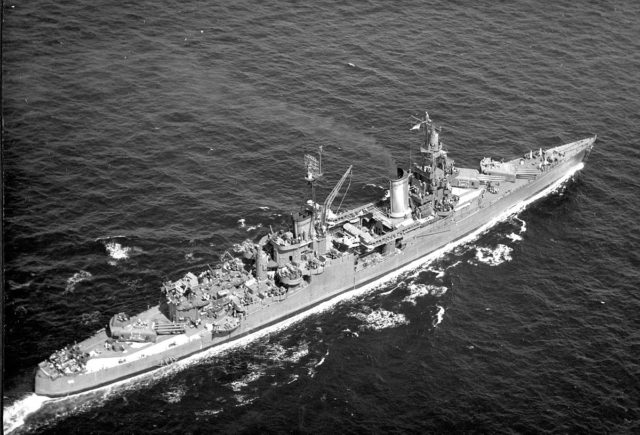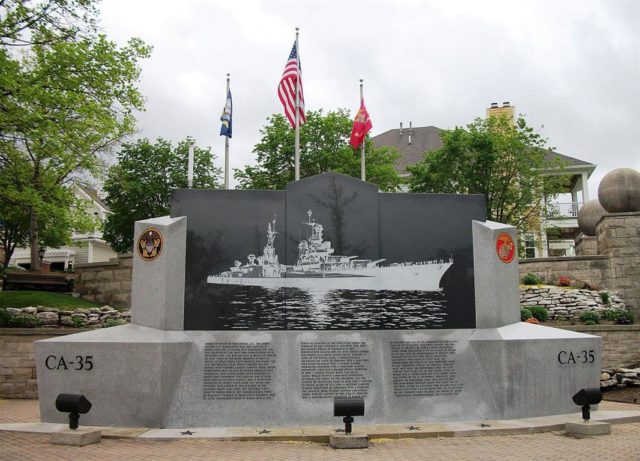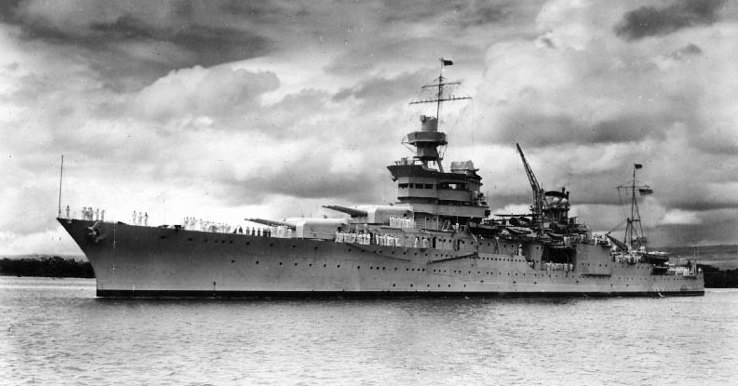“I wish to have no connection with any ship that does not sail fast; for I intend to go in harm’s way.” That quote by American naval hero John Paul Jones provides an apt title for a book that tells the story of the worst disaster at sea in U.S. naval history, and of unprecedented bravery, endurance, and survival.
In Harm’s Way: The Sinking of the U.S.S. Indianapolis and the Extraordinary Story of Its Survivors by Doug Stanton deserves a place on the bookshelf of anyone interested in one of the final American tragedies of World War II.
On July 16th, 1945, the heavy cruiser U.S.S. Indianapolis left San Francisco on a top secret mission. The ship had served honorably throughout the war as the flagship for Vice-Admiral Raymond Spruance, Commander of the Navy’s Fifth Fleet, and taking part in operations around the Gilbert, Marshall, and Marianas islands and the invasions of Peleliu and Iwo Jima. Just a few months before she had suffered a devastating kamikaze attack, taking the lives of nine of her crew.
Now she was assigned the important task of delivering the components of the atomic bomb designated “Little Boy” to the South Pacific island of Tinian. It would be dropped on the Japanese city of Hiroshima just three weeks later. After completing her mission she sailed to Guam to receive new orders, and was dispatched to Leyte Gulf in the Philippines to prepare for the planned invasion of Japan.
Somewhere on the open ocean between Guam and Leyte Gulf, just past midnight on July 30th, a Japanese submarine surfaced and fired six torpedoes at the Indianapolis, two of them striking the ship and setting off fuel tanks and powder stores.The ship sank within twelve minutes. 300 of the 1,196 crewmen aboard died immediately; approximately 900 went into the water, many surviving only because they had been sleeping on deck to escape the muggy heat below.
In the confusion and haste to escape, only a few life rafts were released and most of the men had only life jackets. The next morning sharks began attacking the helpless survivors and would continue to do so throughout the ordeal. Their hopes for a quick rescue waned as hours, then days passed with no sign of help. The deadly effects of dehydration, exposure, and the resulting hallucinatory madness took their toll.
Four days later a Navy PBY Catalina scout plane on routine anti-submarine patrol sighted the survivors and initiated rescue operations. Of the approximately 900 men who had gone into the water only 317 remained alive.

The subsequent naval inquiry laid the blame on the ship’s captain Charles McVay, despite evidence of gross, even criminal negligence on the part of Navy, including failure to warn Capt. McVay of Japanese submarines operating in the area, refusal of a destroyer escort on a route where no other ship had sailed without one previously, and the mishandling of the distress call and intelligence reports of a ship having been sunk in the area, resulting in the lack of an immediate rescue. Capt. McVay was court-martialed, ostensibly for failing to zigzag his ship the night of the incident, marring his career and reputation and ultimately resulting in his suicide in 1968 at the age of seventy.
Doug Stanton is a contributing editor for Men’s Journal magazine, a position he held at Esquire and Outside magazines before that. He holds a MFA from the Writers’ Workshop at the University of Iowa. In 1999 he read an article about a U.S.S. Indianapolis survivor’s reunion and decided to attend and write a piece about it.
He was so impressed with the personality and character of the men he met and their remarkable story that he began an ongoing correspondence and conducted interviews with the survivors and committed himself to telling the story from their point of view. Other books have told the tale of the Indianapolis but Stanton wanted to do it differently, not from a military or historical perspective, but instead emphasizing the human side, the personal experiences of the crew before, during, and after the disaster.
His narrative is told in the third person through the eyes of Capt. McVay, the ship’s surgeon Lewis Haynes, and Marine Private Giles McCoy, and covers not only the events of the disaster itself but also the aftermath, the trial of Capt. McVay and the impact of the ordeal on the lives of the survivors after the war, up to and including the eventual exoneration of Capt. McVay in 2000 when Congress passed an amendment recommending it, which President Clinton signed. The Navy officially added the exoneration to Capt. McVay’s record in 2001. Many say Stanton’s work was instrumental in clearing McVay of responsibility for the sinking, which the survivors had been arguing for angrily and vainly for decades.

Stanton’s prose style is smooth and vividly descriptive and the book is well organized and thoroughly researched. He spent eighteen months interviewing survivors and reviewing Navy documents, many only recently declassified and previously inaccessible. The book includes a comprehensive bibliographical reference. His compassion and respect for the men of the U.S.S. Indianapolis, and his intimate knowledge of their story, gained at first hand, stand out on every page.
Of the myriad stories of courage, sacrifice, suffering, and bravery that came out of World War II, the story of the U.S.S. Indianapolis is one of the most compelling, and In Harm’s Way tells it honestly and definitively.The city of Indianapolis has reason to be proud of its namesake and the men who served on her.
By Bob Price
Bob is a freelance writer and lifelong history buff. An Indianapolis native, he’s had the privilege of meeting the U.S.S. Indianapolis survivors at their annual reunion several times. He currently resides in the wilds of Appalachia, where when he’s not behind a keyboard, he can be found outdoors, if he wants to be.
